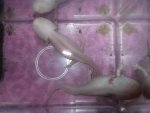memojo1979
New member
- Joined
- Mar 18, 2010
- Messages
- 832
- Reaction score
- 9
- Points
- 0
- Location
- Stoke-on-Trent, Staffordshire
- Country
- England
- Display Name
- Mojo
New arrivals in the sanctuary this week, but gills are so short that I can't tell how to classify them (and, thanks to them being a massive 30cm each, I had to do some moving around of the other sanctuary axolotls + risk putting them in with a leucistic, as I haven't got room to set up another 3ft tank. I used a divider, but they moved it overnight + although I've moved the leucistic into his own temporary tank now because he was biting them, 1 of the whites has been busy laying eggs today!)
Photos are of the tank I temporarily put them in on the 1st day - I was going to use seperate "recovery" tubs, but they're the biggest axies I've ever seen + don't have tubs that are big enough! They are now in a 3ft tank by themselves.
Photos are of the tank I temporarily put them in on the 1st day - I was going to use seperate "recovery" tubs, but they're the biggest axies I've ever seen + don't have tubs that are big enough! They are now in a 3ft tank by themselves.


